| Entries |
| S |
|
Street Life
|
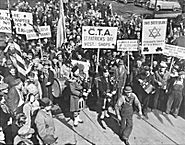
|
The Pre-Horsecar Era
The history of Chicago's street life has been shaped largely by changes in predominant forms of transportation. Before the mid-1850s Chicagoans walked or used private horse-drawn vehicles. The lack of effective paving and sidewalks made it difficult to use the streets for any purposes. Most people tolerated the mud and dust because they had no choice but to walk the largely unpaved streets to get to work. Even well-to-do men angrily petitioned city officials that the lack of sidewalks forced their wives to traipse through a thick coating of spring mud to get to church or to shop. Many women would not have used the downtown district at all had it not been for a group of young “crossing sweepers”—often homeless youth—who swept brick crosswalks that had been installed at the corners. During the 1850s the elevation of the street grade to improve sewer flow also inhibited street life because it was done on a piecemeal basis by individual property owners. Those who lifted their buildings to the new level also elevated their sidewalks, leaving pedestrians to climb up and down tall ladders simply to walk down the street.
From the beginning, the borders between private and public use of the streets frequently blurred. Inadequate fencing allowed farm animals to wander, forcing the county to erect an estray in the courthouse square. And when early ships arrived carrying a miscellany of unconsigned merchandise, their captains set up impromptu retailing areas along boat docks and adjacent streets.
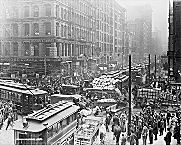
|
The development of the omnibus, an urban version of the stagecoach, began a series of subtle changes in the perception of the street. Patrons could not only travel longer distances in the same amount of time they used to walk, they also enjoyed a voluntary separation from the life of the street, much in the manner of the very wealthy who utilized private carriages. Omnibus riders became more interested in getting home as quickly as possible and began to regard any nontransportation uses of the street as obstacles. In 1857, Mayor “Long John” Wentworth temporarily stopped businesses from invading the sidewalks with merchandise displays and signs, although by the late 1860s it had once more become commonplace for advertisers to cover the exterior walls with billboards and hang banners from wires strung over streets.

|
The Golden Age of the Street
The post-fire decades ushered in the era of most intensive street life, as one observer's view of excitement became another's description of a nightmare. Increasing volumes of human and vehicular traffic, squeezed into a public space that couldn't easily be widened, brought unprecedented congestion. At the same time, the growing anonymity of city life and the general inability of an understaffed city police force to control what went on in the streets created what amounted to laissez-faire conditions. Different social groups continued to compete for control of the same space. Those who might be described as “destination travelers” became a more clearly defined group; their principal use of the street was in getting from one place to another with maximum efficiency. These included travelers moving between hotels and railroad stations, as well as commuters who rushed to work and back home either on foot or on omnibuses and horsecars. The introduction of cable cars in the 1880s and electric trolleys the following decade increased the intrusion of technology on the street, especially during rush hours. The construction of the “L” system between 1892 and 1907 aided this quest for efficiency by creating a whole new layer of street above the surface traffic. Its downtown structure assumed the name “ Loop, ” which had originally described a square of streetcar tracks.
Late-nineteenth-century street life also contributed to the mixed images of Chicago, especially as it was portrayed in illustrated national magazines and in travelers' accounts. After the fire of 1871, civic leaders were proud to point out how the busy streets reflected rebuilding and rebirth. At the same time, illustrations of the bloody railroad strikes of 1877, the 1886 Haymarket Affair, and 1894 Pullman Strike focused on street confrontations and provided a quick stereotype of the instability of society in the mushrooming city. Likewise, the street created an instant impression on such foreign visitors as Rudyard Kipling, who disdainfully described the “collection of miserables” who daily passed through “turmoil and squash.” In 1900, Scottish author William Archer proclaimed that “New York for a moment does not compare with Chicago in the roar and bustle and bewilderment of its street life.” Similarly, many of Chicago's greatest writers—especially those of rural origin—wove their fascination with the energy and variety of the public spaces, especially downtown, into their works. This is evident in the arrival scenes in novels such as Theodore Dreiser's Sister Carrie (1900). Sherwood Anderson's Marching Men (1917) described the way in which the working poor displayed their misery as they tramped the streets or rode the cars. Chicago-born Henry Blake Fuller's The Cliff Dwellers (1893) described the view from a skyscraper as if through the eyes of a bird of prey looking from its nest down at the street. Street life was also prominent in shorter forms of literature. George Ade drew inspiration from peddlers and passersby for his aptly titled column “Stories of the Streets and of the Town,” which ran in the Chicago Record (1893–1900). And of course, the “painted women” of Carl Sandburg's “Chicago,” as well as “Clark Street Bridge” and other pieces among his lesserknown poetry, celebrated workaday street life.
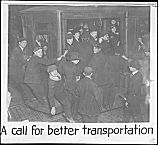
|
Out in the neighborhoods the patterns of street life varied by class. The levels of poverty and congestion in the adjacent housing usually determined the extent of the residents' dependence on the public places for their daily survival. For those at the bottom of the social scale, the street was home. After the fire of 1871, living in public places had become part of the survival strategy for tens of thousands of temporarily homeless victims, many of whom wandered the city for months. During the depression that began two years later, the first generation of tramps (mobile nonworkers) and hoboes (mobile seasonal workers) arrived in Chicago because it was the hub of the nation's growing rail network. By the end of the century thousands of unemployed men populated three Skid Row districts that ringed the downtown. Here, day labor agencies did their hiring curbside, while the local street life consisted of the denizens of cheap restaurants, barrooms, pawnshops, used-clothing stores, and a variety of hotels ranging upwards of “nickel flops.” Amidst them on the sidewalks and streets were such noisy “redeemers” as the Salvation Army band and the Gospel Wagon of the Pacific Garden Mission. It was easy for the more affluent Chicagoans to conflate idlers with the poor, who utilized public spaces as a necessary last resort for survival.
Each step up the economic ladder allowed participation in street activities to become more voluntary. Just above the transients, the tenement neighborhood provided somewhat more permanent dwellings, although conditions still forced a blurring in the distinctions between private and public. The street functioned as a verbal communication conduit within largely nonliterate communities, as well as a place to work and play. Sweltering nights saw much of the population sleeping on the sidewalks, and evictions cast newly homeless families and their meager possessions onto the curbstones. By 1868 there were already enough homeless youth peddling papers on the streets to justify the creation of the Newsboy's and Bootblack's Home, and their ranks grew. Greedy adults also snatched the earnings of large numbers of immigrant juveniles who had been imported during the 1870s to become street musicians.
Mass-produced subdivisions—reached by streetcar and “L”—allowed a further move up the social scale by making affordable such bungalow neighborhoods as Englewood, with its world of small porches, vegetable gardens, and modest fences. Further up the income scale, the lawns and ornamental fences in such substantial middle-class areas as Ravenswood divided neighbors from the street and each other, while children played in parks rather than on the streets. Here, also, neighborhood improvement associations pressured residents to maintain peace and order and beautify their private property, and residents joined private bicycle clubs. Finally, at the top of the social scale, residents of such elite neighborhoods as Prairie Avenue and Astor Street utilized streets primarily for such symbolic activities as the annual opening-day parade to the Washington Park Race Track or for efforts toward public beautification. The wealthy rode in private carriages, ate lunch at downtown clubs, and conversed by telephone or at teas, not on the curbstone.
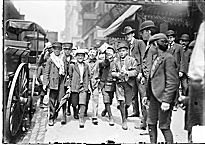
|
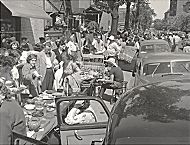
|
This hierarchy of class and privacy explains much about the nature of street life, but superimposed over the story were the temporal rhythms that determined the ebb and flow of activity. In the predawn hours hundreds of workers bought and sold produce at the Randolph and South Water Markets, while lamplighters turned off gas jets and crews from the city and the Municipal Order League watered and swept the surfaces. The morning rush hour saw factory workers walk to work as well as thousands of vehicles cross the bridges into the Loop. Women shoppers began to appear on the streets later in the morning, while the noon hour saw thousands of downtown employees and shoppers pour out of buildings in search of lunch. In the midafternoon, women shoppers left downtown to be home when their children returned from school. Then began the evening rush hour of streetcars and pedestrians. Workers walking home along “Dinner Pail Avenue” (Milwaukee Avenue) near Chicago Commons settlement house were so numerous that they raised clouds of dust.
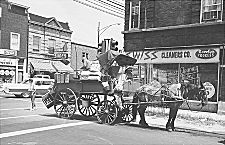
|
The life of the street reflected other cycles of life, including age and seasonality. Cold weather drove indoors all but the heartiest peddlers of necessities, while others restocked with holiday merchandise. Transit lines utilized closed-side equipment, heated by stoves, instead of the open-style cars which brought summer riders close to the sounds and smells of the street. The street also meant different things to people who were near the beginning or the ending years of life. The street was a microenvironment of socialization where youths set their own rules and learned the ways of the world. Their games and songs were a part of city folklore. Youth gangs, however, had already begun battling for domination of neighborhood turf by the mid-nineteenth century. At the other end of the spectrum, aged Civil War veterans came to the Loop post office to collect their monthly pension checks, and many elders sold newspapers or worked at such jobs as “baby watcher” outside of outlying department stores.
The New Age of the Street

|
At the same time, decades of urban growth had fostered the process of sorting urban functions by land use (wholesale, retail, residential), social class, and ethnicity. The heterogeneous urban mixture of the mid-1800s had given way to a pattern of more homogeneous districts of social classes and neighborhoods. Citywide antinoise laws were aimed at silencing obtrusive peddlers and imposing quietude and order on middle-class neighborhoods as well as the Loop. In 1913 the city began an effort to push all street trades out of middle-class areas and into the Maxwell Street district. At the same time, the enforcement of antiloitering laws gradually drove the transient population into Skid Row districts to the north, south, and west of the Loop. The goal of these efforts was a more orderly street life that was confined to what were deemed appropriate districts.
Finally, the efficiency of crowd control during the World's Columbian Exposition inspired Chicagoans to believe that they could impose a similar sense of beauty and order on the rest of the city. Infrastructure innovations included newly designed bridges and the elevation of steam railway tracks to remove crossing hazards. But nothing symbolized the desire for aesthetic and efficient streets more than Daniel Burnham's Plan of Chicago (1909). Its emphasis on traffic flow countered the traditional working-class social uses of the street. The plan's impressionist-style illustrations by Jules Guerin emphasized the celebrational city as if viewed on a warm Sunday afternoon. Meanwhile, a series of statues financed by the Benjamin F. Ferguson Fund stressed the streets' artistic rather then survival possibilities. Beauty and efficiency, which were supposed to contribute to the economy by making workers happier and more contented, also represented a triumph of the middle- and upper-class view of what street life should be.
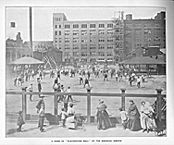
|
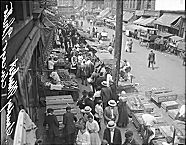
|
After V-J Day—when the streets were once more used to celebrate—and the period of postwar recovery of the national economy, the street became a barometer of another kind of urban transformation. Pundits predicted that urban renewal, high-rise apartments, air conditioning, and television would kill off neighborhood street life. The newspaper box, for instance, displaced hundreds of human vendors, in part because the general decline in public transit ridership put so many former pedestrians into autos. The idea of the street as employer of last resort survived in impoverished neighborhoods. Peddlers elsewhere became such a rarity that the visit of the once-ubiquitous scissors grinders now became the subject of great excitement. During the 1950s the press began to note a loss of neighborhood social life that had traditionally grown out of public places. The front porch or stoop, which had fostered neighboring on warm evenings, had begun to give way to air conditioning and television. And in the poorest neighborhoods, high-rise public housing completely destroyed the role of the street in the community.
The expressway system, which removed much of the traffic from the major city thoroughfares, represented the near triumph of the idea of the single-use street: the only possible function was as a place for cars to drive. (Chicago managed to create an ingenious exception by routing rapid transit down the otherwise-useless median strip.) Neighborhoods that lay in the way were now regarded as irrelevant piles of rubble-to-be, and the older transient districts were flattened to make way for superhighways. Meanwhile, at the other end of the auto commute, the mass production of a limited number of house designs in booming suburbia was reflected in the mass creation of quiet residential streets. Juvenile trees matched tricycles and other juvenile transportation equipment. Sociologists noted that cul-de-sacs favored neighborliness. Even the temporal rhythm of the suburban street was different. Rush hour dominated the clock, although the shopping centers that displaced older commercial streets were now open evenings.
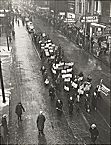
|
But even during this nadir, there had been a few hopeful signs. Mayor Richard J. Daley had revived the downtown St. Patrick's Day Parade in 1956, an important symbolic gesture, while Chinese, Germans, Greeks, Poles, and others also used the streets for celebrations. Triumphs achieved by Chicago sports franchises, as well as the symphony, astronauts, and other dignitaries, prompted massive parades. Meanwhile, newly arrived Latin American and Asian ethnic groups were quietly bringing with them their own celebratory processions and parades, as well as a strong tradition of street trading. And the taxicab industry continued to allow the kind of low-capital entry into American entrepreneurship for immigrants that street trades have always provided to newcomers.
Neighborhood block parties and the gradual return of outdoor dining were the first signs of the manner in which the booming economy of the late 1980s and 1990s and a gentrified inner city would bring about a revival of activity. New office towers and the conversion of factories and warehouses into apartments nurtured a revival of center-city dining. But contemporary street life only hints at the rich variety of activities that were once there. What returned was closer to the “city beautiful” of the Burnham Plan than it was to the workaday intensity of the late nineteenth century. Chicagofest, followed later by Taste of Chicago, the Blues and Gospel Music Festivals, and a patchwork of neighborhood festivals, represented a highly selective new form of Disneyfied street life, carefully planned, advertised, predictable, sanitized, and policed.
During the late 1990s, many of the last remnants of the old street life were threatened. Police removed the homeless from Lower Wacker Drive, while gentrification nibbled away at the old south and west transient districts. The demise of SRO hotels and the charities that supported their tenants resulted in the removal of most of the transients, many of whom had been dumped from state institutions. Meanwhile, campus expansion at the University of Illinois at Chicago brought an end to the storied Maxwell Street Market, while the city launched a crackdown on ethnic food vendors, proclaiming them a nuisance and health hazard.
The Encyclopedia of Chicago © 2004 The Newberry Library. All Rights Reserved. Portions are copyrighted by other institutions and individuals. Additional information on copyright and permissions.